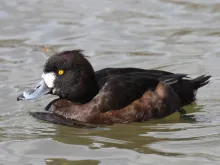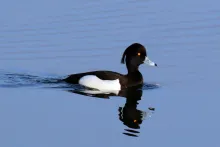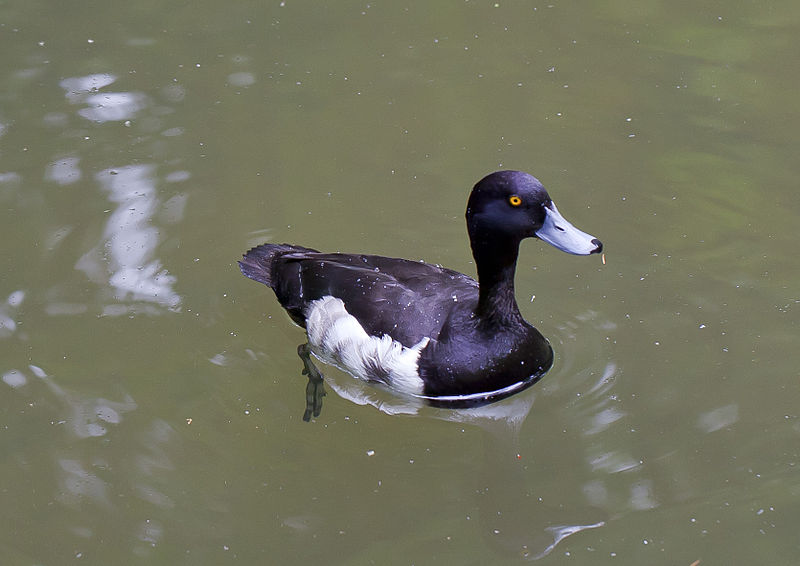
Tufted duck (Aythya fuligula)
Species name
- Dutch name:
- Kuifeend
- English name:
- Tufted duck
- German name:
- Reiherente
- French name:
- Fuligule morillon
- Scientific name:
- Aythya fuligula
Scientific classification
- Order:
- Anseriformes
- Family:
- Anatidae
- Onderfamilie:
- Aythyinae
- Genus:
- Aythya
Description
- Description:
Male:
Black Head and neck, glossed purple with a Green iridescent in the right-angled light, and with long, pendent crest from rear of crown. Breast black, sharply demarcated from white belly and flanks; vent and sometimes, lower rear flanks very finely vermiculated grey and white. Upperparts black, scapulars with greenish gloss; tail-converts and tail black. Upper wing converts black, and broad white bar across black tipped seconderies and inner dark primaries, outer primaries being mainly blackish; under wing whitish. Bill pale blue-grey, with small black tip and nail, and usually, with subterminal band. Legs and feet grey. Iris bright yellow.Female:
Dark brown and head and neck with short crest, latter somtimes diffcult to see . Many females have white by base of bill, often more extensive in winter. lighter brown on neck breast and, especially, flanks, sometimes with reddish tinge, and, in winter, breast often lightly mottled whitish; wish belly , brown vent and, usually brown undertail converts but, on some birds, these whitish. Upper parts vary from dark brown to almost black. Upper wing converts dark brown, and broad white bar across black tipped seconderies and inner dark primaries, outer primaries being mainly brownish; under wing whitish. Bill dark pale blue-grey, with small black tip and nail, and usually, with lighter subterminal band. Legs and feet grey. Iris bright yellow.Juvenile:
Paler brown on head and upper parts, where feathers edged buff, except on crown, which is darker; pale area on lores. Flanks with buff scallops. Iris brown. gets adult plumage after first year. females may not have yellow iris after first year or may never get a yellow eye.
Standard Measurements
- Body Length (cm):
- The male (drake) of the Tufted duck measures approximately 42-48 centimeters. The female measures approximately 39-44 centimeters.
- Body Weight (grams):
- The male will weight about 753-1028 gram. The female will weight about 629-906 gram.
The weight is notoriously variable and can only be used as indication!
- Note:
Tufted ducks are hardy, easy to manage, widely kept, good in mixed collections; they prefer large lakes with deep water for diving and natural food available. Feed as other diving and dabbling ducks (floating pellets, green food, grass) plus extra animal material if no natural food is available. Like to dive for food.
These ducks are easy to breed. They breed best on a large, deep pond or lake, not over-populated, and with natural bankside vegetation such as rushes or reeds to nest in (they may also use baskets and shallow boxes close to water). Eggs are laid from mid-May to June. These ducks brood reliably if undisturbed; ducklings may be parent reared in small enclosures (where they may be easily checked) or very large areas, otherwise hand-rearing may be used. Ducklings are not difficult to rear, although they are highly insectivorous initially and live insects are useful for feeding as well as duckweed and starter crumbs.
This species commonly hybridises, particularly with other Aythya species; hybrids also reported with Anas spp., Netta spp., Bufflehead (Bucephala albeola), Common goldeneye (Bucephala clangula).
- Breeding:
- The female Tufted duck usually lays from 6-11 olive-grey or greenish-grey eggs and incubates them for 23-26 days.
- Artificial incubating:
The ideal relative humidity for incubating most waterfowl eggs is 55% (ground nesters) and 40% (cavity nesters). The temperature is usually 37.4°C. Set ventilation as recommended by the incubator manufacturer. Eggs must be turned, either automatically or by hand, a minimum of 4 times a day. As the duckling develops there is a loss of water from the egg and the air sac gets bigger. In normal development of an egg with a 23-26 days incubation, the air sac occupies about a third of it three days earlier. Cleanliness is vital and ideally eggs should be moved to a separate hatcher at this point, where the humidity should be increased to 65% and even higher once they have pipped internally.
- Bird banding:
- Recommended closed leg band ring size for the Tufted duck is 9 mm.The leg band ring can only be applied on a young small diving duck at around 12 days old.
- It doesn't matter what leg that you band, but it's good to have a consistent system. Suggested: Left leg = Female, Right leg = Male
- Rearingfeed:
-
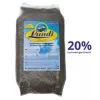
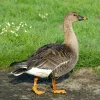

Floatable special rearing feed for all types of aquatic ornamental fowl - especially for the cultivation of trees as well as greening ducks.
This well-balanced complete feed with 20% protein content convinces above all by its good compatibility and forms the basis for visibly healthy growth from day one.
Made exclusively from wholesome and selected raw materials, Lundi Micro Regular is also ideally suited for the year-round feeding of waterfowl.
- Maintenance food:
-



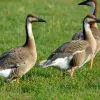

Lundi Regular with a protein content of 20%, valuable Spirulina and high-quality by-products is optimally balanced in its composition maintenance food for water ornamental fowl of all kinds. Especially green teal and Whistling ducks that are not dependent on a very high protein content, are well supplied.
Lundi Regular contains all the minerals and vitamins in full form that are important for the animals. Therefore also suitable as breeding food.


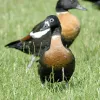


Floating full food for all sea ducks, green ducks, eider ducks and geese, especially in the moulting and breeding phase ideally suited. Packed with wholesome raw materials, natural vitamins and trace elements, this performance food with a protein content of 30% forms the basis for lifelong vitality.
- Regulation:
- Europese soort
- Regulation:
Het is niet verboden om deze vogels te houden die van nature in Nederland voorkomen, op voorwaarde dat deze vogels in gevangenschap zijn geboren; nakweek dus. Deze vogels zijn voorzien van een gesloten pootring. Het is wel verboden om deze vogels te houden die in het wild gevangen zijn. Alleen bepaalde instanties, zoals vogelasiels en vogelhospitalen, zijn bevoegd om jonge en gewonde wilde vogels te houden. Deze bescherming van vogels wordt vormgegeven door schadelijke handelingen te verbieden zoals:het doden, verwonden, vangen, bemachtigen en met het oog daarop opsporen van vogels (art. 9 Flora- en faunawet); het opzettelijk verontrusten van vogels (art. 10 Flora- en faunawet);het beschadigen, vernielen, uithalen, wegnemen en verstoren van nesten, holen of andere voortplantings- of vaste rust- of verblijfplaatsen van vogels (art. 11 Flora- en faunawet);en het zoeken, rapen, uit het nest nemen, beschadigen of vernielen van eieren van vogels (art. 12 Flora- en faunawet).

